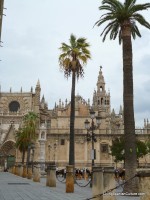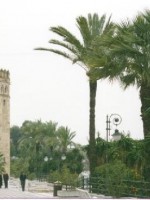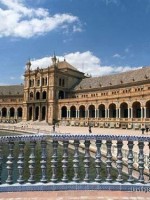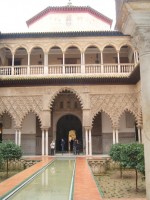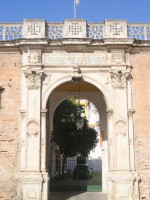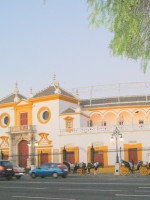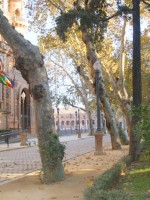History of Sevilla:
The city’s early origins go back to the first millennium B.C., but its historical importance began with the founding of the first Phoenecian colonies and the Kingdow of Tartassos. Much later, the strategic location of Hispalis, as it was the known, consolidated its position as one of the chief cities of the Roman province of Betis, becoming a district capital and an area of economic influence which was to grow Bishop of the city and one of the most brilliant personalities of his time.
In 711 A.D. the city was conquered by Muslim forces from North Africa and in the 11th century Sevilla (Isbiliya in Arabic), became the greatest of the independent kingdoms of Taifas of Al-Andalus. It is during this period that the building of the Alcazar took place (913 A.D.) and the city walls were extended. From the middle of the 12th to the middle of the 13th centuries it was the capital of the Almohades, who in 1248 surrendered the city to Fernando III, a Christian monarch who imposed reforms according to the policies of the time.
The discovery of America brought an era of great splendor to Seville with the granting in 1503 of the monopoly in commercial traffic with the Indies. In this period, there took place the wedding of the Emperor Carlos V in the Alcazar as well as the building of the Cathedral and many churches, convents and palaces, giving rise to the saying “he who has not seen Seville has never seen a marvel”. The city enjoyed a swift cultural and creative expansion which attracted some of the mos important intellectual figures of the time besides artists such Murillo, Velazquez, Zurbarán, etc.
The plague epidemic in 1649 carried off half the city’s inhabitants, marking the beginning of a period of decline not improved by the river growing progressively less navigable, for which reasons in 1680 the privilege of commerce with the Indies was lost to Cadiz.
The city’s slow recovery was set back by the War of Independence 18th century, during which it was subjected to repeated attacks and plundering, and it was not until the early Twentieth Century, when the Iberian-American Exposition of 1929 brought about an exuberant urban renovation, that it was finally on its path to a bright future. In 1982 Seville became the capital of the Autonomous Community of Andalucia and in 1992 visitors to the Universal Exposition from the whole world over were to fall in love with a beautiful metropolis in which no modern services were lacking.
The province of Seville being the largest in Andalucia with it 14.000 square kilometers, makes it one of the most visited by tourists. The warmth of its people, the shady corners in its ancient cities, the history of its towns and villages, its landscapes, the Easter processions which are the culmination of its popular fervor and last but by no means least, the April Fair of Seville (Feria de Abril) and explosion of popular joy, all these and many others contribute to fix in visitors memories a warm image which they will never forget.
-
SEVILLE, A WONDERFUL CITY
Sevilla is the artistic, cultural, and financial capital of southern Spain. It is the capital of the autonomous community of Andalusia.
If you love Spain you’ll love Sevilla, the essence of Andalucia, a mixture of cultures: Arab, Jewish and Roman.
You can not miss this wonderful city; you have to visit it at least once in a life time. Sevillanos are very friendly people and you’ll quickly discover that having wine in one of their many terraces is a pleasure that words cannot describe.
Moorish Heritage Seville is more than 2,000 years old. The passage of the various civilizations, instrumental in its growth, has left the city a distinct personality, and a large and well-preserved historical center. Although it has a strong medieval, renaissance and baroque heritage, the city received heavy influences from Arabic culture. If you love Art and Architecture, then you have an obligatory date with Sevilla. This impressive city is typically Spanish, and it has one of the most important monumental legacies in the world.
The city keeps the largest Gothic Architectonics treasures of the world: The Cathedral and a large ensemble of monuments, Palaces, Gardens, narrow streets, beautiful plazas with well-kept courtyards “patios” which are necessary to highlight.
-
MAJOR FESTIVALS IN SEVILLE
-
THE 7 CITY SIGHTS OF SEVILLE YOU CAN NOT MISS
SEVILLE CITY SIGHTS

